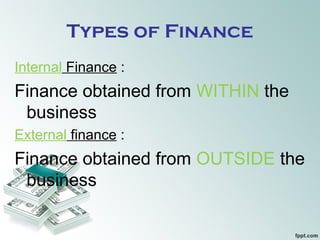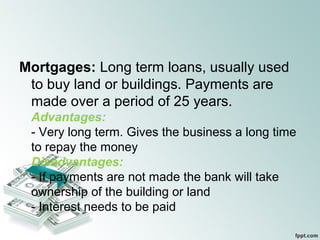sources of finance
- 2. What is finance? Definitions Finance: This is money Source of finance: This is WHERE we get finance (money from)
- 3. Why do businesses need finance?? Starting up a new business Moving to new premises Take over of another company Replacing old machinery Internal growth
- 4. Types of Finance Internal Finance : Finance obtained from WITHIN the business External finance : Finance obtained from OUTSIDE the business
- 5. Internal Sources of finance Retained Profit: The profit left after all expenses have been paid Advantages: -It doesn’t need to be paid back Disadvantages: -The profits of a small business may be too low to be of use -A new business won't have any retained profit
- 6. Sale of Assets: This is when a company sells old assets which it no longer needs Advantages: - Saves space as old assets are no longer there - It makes better use of the business’ capital Disadvantages: - New businesses won’t have any assets to sell - It’s time consuming and the business might not find a buyer
- 7. Owner’s Savings: The owners of the business can use their savings as finance in the business. This is only available to sole traders and partnerships Advantages: - Quickly available - No interest will need to be paid Disadvantages: - The owner might not have enough savings - It’s very risky due to unlimited liability
- 8. Internal finance Short term (up to 12 months) cash in the bank Medium term (1-3 years) Retained profit Sale of assets Long term (3 years or more) Owners investment
- 9. External Sources of finance Bank Overdraft: This allows the company to spend more money from their account than is actually in it. Advantages: - It’s easily arranged and flexible - Cheap as the company only has to pay interest on the amount overdrawn at any one time Disadvantages: - The bank can ask for the overdraft to be repaid whenever they want to and with short notice - Cannot be used to finance long term assets - Interest need to be paid
- 10. Trade Credit: Gives the business around 1-3 months to pay after purchasing supplies Advantages: - No interest - Useful as the company can sell its finished product and sell it before having to pay the suppliers Disadvantages: - The supplier may refuse to give discounts or completely stop trade with the business if payments are not met. - Suppliers see smaller, new businesses as unreliable, therefore they might not allow them to pay on credit.
- 11. Bank Loan: This is where a business borrows money from a bank for a period of 1-10 years Advantages: - The business can easily plan ahead, as the interest rate is fixed - Large businesses can get lower interest rates as they are more reliable - Good for both long-term and short-term Disadvantages: - Small companies will need to pay higher interest rates - Interest need to be paid - Collateral is needed
- 12. Leasing: This is when a business borrows an asset and uses it in return for monthly payments Advantages: - The company will not have to spend a lot of money on buying the asset - The firm will be able to easily update their equipment - The leasing company will take care of maintenance and replace damaged assets Disadvantages: - In the long term, leasing will be more expensive than actually purchasing the equipment
- 13. Hire Purchase: Allows a firm to pay for an item over a long period of time in the form of monthly payments Advantages: - The business will not have to find a lot of money to buy the item Disadvantages: - Interest rates are very high. It may be better to take out a bank loan - A cash deposit needs to be paid at the start
- 14. Mortgages: Long term loans, usually used to buy land or buildings. Payments are made over a period of 25 years. Advantages: - Very long term. Gives the business a long time to repay the money Disadvantages: - If payments are not made the bank will take ownership of the building or land - Interest needs to be paid
- 15. Issue of Shares: only available to limited companies. Private limited companies (Ltd’s) can sell shares to friends and family. Public limited companies can sell shares to the general public Advantages: - Does not have to be repaid - No interest - Status and reputation of a company can be raised - Having shareholders increases the financial security of the business Disadvantages: - Dividends need to be paid to shareholders - Issuing shares takes time and requires lots of paperwork - Ownership of the company will be complicated and there is the danger of takeovers
- 18. Making the right choice To make the right choice, a number of factors will need to be considered. To simplify the process, these factors can be summed up in five questions: - What source is available? (depending on the size of the company) - What is it for? Short term or long term? - How much money is needed? - What are the risks involved? - What is the cost of the finance?


















